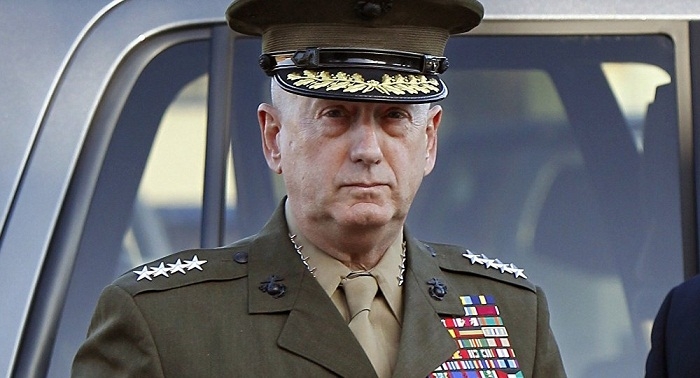In an hourlong news conference at the Pentagon, Mr. Mattis took issue with human rights groups and other critics who have warned that the military’s new authorities freeing them from Obama-era constraints on airstrikes and raids against insurgents in Yemen and Somalia have jeopardized the safety of civilians in those countries.
“I want to emphasize here there has been no change to our rules of engagement, and there has been no change to our continued extraordinary efforts to avoid innocent civilian casualties,” Mr. Mattis told reporters.
Amid a generally upbeat assessment of the campaign against the Islamic State — known internally now as “D-ISIS” for “Defeat ISIS,” using another name for the group — Mr. Mattis struck a sobering note, saying the fight “is not going to be over soon.”
Mr. Mattis was joined by Gen. Joseph F. Dunford Jr., the chairman of the Joint Chiefs of Staff, and Brett McGurk, the United States special envoy to the coalition against the Islamic State.
The timing of their comments, which represent the most comprehensive report on the Trump administration’s campaign against the Islamic State, was not happenstance: It came as Mr. Trump headed out on a nine-day visit to Saudi Arabia and Europe, where he will not only seek to rally support for the campaign against the Islamic State in Syria and Iraq, but also try to gain commitments from NATO for more troops in Afghanistan.
Mr. Trump seemed pleased enough with his top generals on Friday to renominate General Dunford and Gen. Paul J. Selva of the Air Force, the vice chairman of the Joint Chiefs of Staff, each to a second two-year term.
At the Pentagon, General Dunford ticked off some of the campaign’s accomplishments, including reclaiming 55 percent of the territory the Islamic State has seized in Syria and Iraq since 2014. He said the effort has also significantly reduced the group’s ability to finance its terrorist operations and draw new recruits into Iraq and Syria, down to fewer than 100 a month from a peak of 1,500 a month.
Other senior American officials, including Nicholas J. Rasmussen, the director of the National Counterterrorism Center, have offered a more measured analysis of the impact of the global fight. Mr. Rasmussen said this month that “the global reach of ISIS remains largely intact” despite the group’s territorial losses.
American officials now believe that about 40,000 prospective fighters from more than 120 countries have traveled to, or tried to travel to, the war zones in Iraq and Syria since 2014.
In explaining the Trump administration’s strangle-the-stronghold strategy, Mr. Mattis underscored a looming menace: “The foreign fighters are the strategic threat should they return home to Tunis, to Kuala Lumpur, to Paris, to Detroit, wherever.”
But it is not at all clear that the Obama administration’s strategy, which General Dunford himself shaped and Mr. McGurk defended, was to let Islamic State fighters escape to fight another day. American military officers have also said it was the Iraqis’ idea — not the Americans’ — to send the Iraqi Army west of Mosul to cut off the city.
The Pentagon officials on Friday cited examples of the accelerated fight against the Islamic State.
After months of debate, beginning under President Barack Obama, Mr. Trump last week approved a plan to arm Syrian Kurds so they can help retake Raqqa from the Islamic State, a strategy that has drawn deep opposition from Turkey, a NATO ally.
American military commanders have long contended that arming the Y.P.G., a Kurdish militia fighting alongside Syrian Arab forces against the Islamic State, is the fastest way to seize Raqqa, the capital of the militants’ self-proclaimed caliphate.
Turkey has objected strongly to arming the Kurds, raising fears that Ankara could curtail cooperation with Washington in the continued battle.
General Dunford said Friday that the United States had already stockpiled weapons and equipment — which other officials said could include heavy machine guns, mortars, anti-tank weapons, armored cars and engineering equipment — and would begin distributing them soon to Kurdish and Arab fighters in the anti-Islamic State coalition.
General Dunford highlighted the recent decision to allow American military advisers to accompany Iraqi troops down to the battalion level, particularly in operations in Mosul, although it is unclear how often that happens. The Americans’ proximity to Iraqi forces in the complex urban terrain allows them to provide better support.
Mr. Trump’s top advisers are also recommending sending 3,000 to 5,000 additional American troops to try to break a stalemate in the 15-year war in Afghanistan. That final decision, Mr. Mattis said, is still pending.
American forces now have broader authorities to combat militants in parts of Somalia and Yemen. But General Dunford cited a recent mission in Syria as a less recognized illustration of the latitude the Trump administration has given its commanders to carry out operations without prolonged review in Washington: an effort to take control of the Tabqa Dam on the Euphrates River near Lake Assad, the nearby town of Tabqa and a local airfield.
That operation, which started in March, was the first time United States helicopters airlifted hundreds of Syrian fighters and their American advisers into battle behind enemy lines in the campaign against the Islamic State.
With Mr. Mattis suggesting that the fight against the Islamic State would still take years, not months, to complete, he was asked what success would look like.
“You’ve got to drive them down to a point that police can handle it,” Mr. Mattis said. “Police can’t handle a force that’s driving tanks and using artillery, or has thousands of fighters in mobile vehicles that allow them to range far and wide.”
/NY Times/
More about:
















































